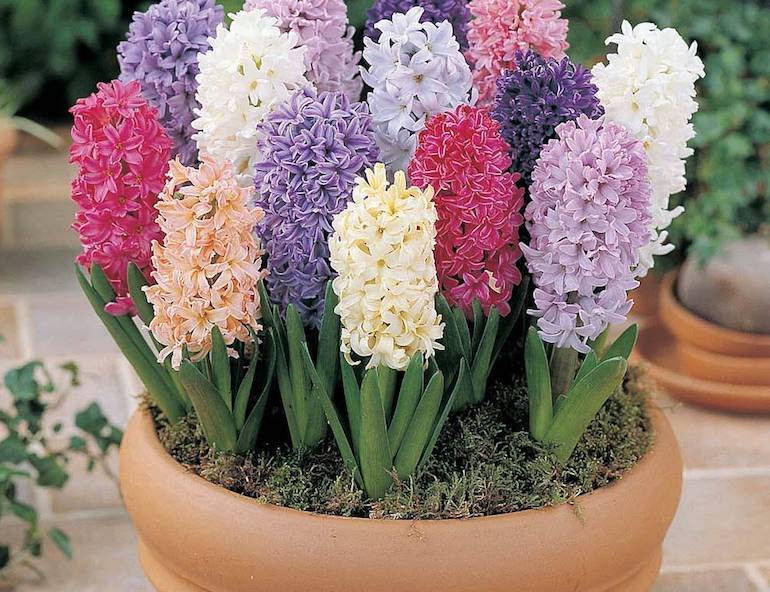The best time to plant indoor hyacinth bulbs is in the fall, from September to November. This timing allows for proper root development.
Planting indoor hyacinth bulbs in the fall ensures they have enough time to establish roots before blooming in late winter or early spring. Hyacinths require a cold period to stimulate growth and flower production, making fall the ideal season for planting.
Ensure the bulbs are placed in a cool, dark area for about 10-12 weeks, mimicking their natural winter dormancy. After this period, move them to a warmer, well-lit spot to encourage blooming. Proper timing and care will result in vibrant, fragrant flowers that brighten your indoor space during the colder months.

Credit: www.thrive.org.uk
Introduction To Indoor Hyacinth Cultivation
Hyacinths are beautiful and fragrant flowers. They add charm to any indoor space. Planting them indoors is a delightful experience. Knowing the best time to plant is crucial. This guide will help you start your indoor hyacinth journey.
The Allure Of Hyacinths Indoors
Hyacinths bring a burst of color and scent to homes. These flowers are easy to grow and maintain. Their vibrant colors can brighten any room. With proper care, they bloom magnificently indoors.
- Fragrant blooms: Hyacinths are known for their sweet scent.
- Color variety: They come in many colors like pink, blue, and white.
- Easy care: They require minimal maintenance.
Key Considerations Before Planting
Before planting hyacinth bulbs, consider a few factors. Timing, soil type, and pot selection are crucial. Understanding these will ensure healthy growth.
- Timing: Plant bulbs in late fall for spring blooms.
- Soil type: Use well-draining soil for best results.
- Pot selection: Choose pots with good drainage.
By focusing on these key points, your hyacinths will thrive indoors. Happy planting!
Understanding Hyacinth Bulb Dormancy
To grow beautiful indoor hyacinths, you need to understand bulb dormancy. Hyacinth bulbs go through a dormancy cycle which is crucial for their growth. Knowing when and how to break this dormancy is key for indoor planting.
The Dormancy Cycle Of Hyacinth Bulbs
Hyacinth bulbs have a natural dormancy period. During dormancy, the bulb rests and conserves energy. This period is essential for the bulb’s health and future growth.
Here is a table summarizing the dormancy cycle:
| Stage | Description |
|---|---|
| Dormancy | The bulb rests and conserves energy. |
| Pre-planting | Bulbs need chilling to break dormancy. |
| Growth | The bulb starts to grow roots and shoots. |
Breaking Dormancy For Indoor Growth
To break dormancy, you need to chill the bulbs. Place the bulbs in a cool, dark place for 10-12 weeks. A refrigerator works well for this purpose.
Follow these steps to prepare your hyacinth bulbs:
- Choose healthy, firm bulbs.
- Place bulbs in a paper bag or container.
- Refrigerate for 10-12 weeks at 35-45°F (1-7°C).
After chilling, plant the bulbs in pots with well-draining soil. Water them lightly and place them in a sunny spot. Soon, you’ll see beautiful hyacinths blooming indoors.
Seasonal Timing For Planting Hyacinths Indoors
Planting indoor hyacinth bulbs is a rewarding activity. It brings vibrant colors and delightful scents to your home. Proper timing ensures healthy growth and blooming.
Ideal Months For Starting Your Bulbs
Starting your hyacinth bulbs at the right time is crucial. The best months to begin are September to October. These months offer the perfect balance of conditions. Planting too early or too late can affect the bloom quality.
| Month | Condition |
|---|---|
| September | Ideal for planting |
| October | Optimal for growth |
| November | Late planting, needs extra care |
Temperature Requirements For Optimal Growth
Hyacinths need specific temperatures to thrive. Maintaining the right temperature is crucial.
- Initial phase: Keep bulbs at 40-50°F (4-10°C) for 12-14 weeks.
- Growth phase: Move bulbs to 60-70°F (15-21°C) for sprouting.
- Blooming phase: Keep at 65-70°F (18-21°C) for best flowers.
Ensuring proper temperature at each stage encourages robust growth and beautiful blooms.
Pre-planting Preparation Steps
Preparing to plant indoor hyacinth bulbs involves several important steps. These steps ensure your bulbs grow healthy and produce beautiful flowers. Follow these guidelines to give your hyacinth bulbs the best start.
Choosing The Right Bulbs For Indoor Planting
Start by selecting high-quality hyacinth bulbs. Look for bulbs that are firm, plump, and free of mold. Larger bulbs often produce bigger and more vibrant blooms. Choose bulbs that are specifically labeled for indoor planting. This ensures they are pre-cooled and ready for indoor growth.
Soil And Container Preparation
Next, prepare the soil and containers for planting. Use a well-draining potting mix to prevent waterlogging. The potting mix should be rich in organic matter. You can add compost for extra nutrients.
| Step | Action |
|---|---|
| 1 | Select a container with drainage holes. |
| 2 | Fill the container with potting mix up to 2 inches from the top. |
| 3 | Place the bulbs pointed end up into the soil. |
| 4 | Ensure bulbs are spaced about 1 inch apart. |
| 5 | Cover the bulbs with more potting mix. |
Water the soil lightly after planting. This helps to settle the soil around the bulbs. Place the container in a cool, dark place to encourage root growth. Check the soil moisture regularly to keep it slightly damp but not soggy.
Forcing Bulbs For Winter Blooms
Forcing Bulbs for Winter Blooms allows you to enjoy hyacinths indoors during winter. This process tricks bulbs into blooming earlier than they would in nature. Follow these steps to create a beautiful, fragrant indoor garden.
Steps To Force Hyacinth Bulbs
- Select Quality Bulbs: Choose large, firm bulbs. They should be free from blemishes.
- Prepare the Bulbs: Place bulbs in a paper bag. Store them in the refrigerator for 12-14 weeks.
- Plant the Bulbs: Use pots with drainage holes. Fill the pots with a well-draining potting mix. Plant bulbs with the pointed end up. Cover them with soil, leaving the tips exposed.
- Provide Darkness and Coolness: Place pots in a dark, cool area (35-48°F). Basements or unheated garages work well.
- Watering: Keep the soil moist but not soggy. Check regularly.
- Move to Warmer Area: After 12-14 weeks, move the pots to a warmer spot (60-70°F) with indirect light.
Aftercare For Forced Bulbs
Once your hyacinth bulbs bloom, proper care extends their beauty.
- Watering: Keep the soil moist. Do not let it dry out.
- Light: Place the pots in bright, indirect sunlight.
- Temperature: Maintain a cool environment (60-65°F). Avoid placing them near heat sources.
- Support: Hyacinths can become top-heavy. Use small stakes if needed.
These steps ensure your indoor hyacinths bloom beautifully during winter. Enjoy the vibrant colors and sweet fragrance in your home.
Post-planting Care And Maintenance
After planting your indoor hyacinth bulbs, proper care and maintenance ensure healthy growth. This section covers essential steps to nurture your hyacinths.
Watering And Feeding Your Indoor Hyacinths
Watering is crucial for healthy hyacinth growth. Keep the soil moist but not soggy. Overwatering can cause bulb rot. Use a watering can with a narrow spout to control the water flow.
Feed your hyacinths once a month with a balanced liquid fertilizer. Choose a fertilizer with equal parts of nitrogen, phosphorus, and potassium. This encourages strong root and flower development.
| Action | Frequency |
|---|---|
| Watering | When the topsoil feels dry |
| Feeding | Once a month |
Lighting Requirements For Robust Growth
Hyacinths need bright, indirect light for optimal growth. Place your pots near a window that receives sunlight. Avoid direct sunlight as it can scorch the leaves.
If natural light is insufficient, use a grow light. A grow light can provide the necessary intensity and spectrum. Keep the light on for 12 to 14 hours a day for best results.
Rotate your hyacinth pots every few days. This ensures even light exposure and prevents leaning.
- Bright, indirect light
- Use grow lights if needed
- Rotate pots regularly
Troubleshooting Common Indoor Hyacinth Issues
Growing indoor hyacinth bulbs can be a rewarding experience. But sometimes problems arise. Knowing how to troubleshoot common issues ensures healthy growth and blooming.
Dealing With Pests And Diseases
Pests and diseases can harm your hyacinth. Watch for signs early.
| Pest/Disease | Signs | Solution |
|---|---|---|
| Aphids | Sticky leaves, distorted growth | Spray with soapy water |
| Spider Mites | Webbing on plants, yellow leaves | Use insecticidal soap |
| Gray Mold | Grayish spots on leaves | Remove affected parts |
Keep your plants clean to avoid pests. Regularly inspect leaves for any signs.
Addressing Growth And Blooming Problems
Sometimes hyacinth bulbs face growth or blooming problems. Here’s how to fix them:
- Insufficient Light: Place bulbs near a bright window.
- Overwatering: Ensure soil is well-drained. Avoid waterlogging.
- Temperature Issues: Keep bulbs in a cool spot, around 60-65°F.
- Nutrient Deficiency: Use a balanced fertilizer during growing season.
Monitor the growing conditions of your hyacinth. Adjust as needed for optimal growth.
By addressing these common issues, your indoor hyacinth bulbs will thrive and bloom beautifully.

Credit: www.gardenersworld.com
Transitioning Bulbs Post-bloom
After your indoor hyacinth bulbs have bloomed, a crucial transition period begins. Managing the post-bloom phase correctly ensures healthy bulbs for next season. This section covers the essential steps in transitioning your bulbs effectively.
What To Do With Bulbs After Flowering
Once the hyacinth flowers fade, cut off the spent blooms. Leave the green foliage intact. The leaves collect energy for the bulbs through photosynthesis.
Place the pots in a sunny location. Water the plants regularly but avoid waterlogging. Gradually reduce watering as the leaves start to yellow and wither.
Remove the bulbs from the soil once the foliage has died back completely. Gently clean off any remaining soil. Inspect the bulbs for signs of disease or damage and discard any unhealthy ones.
Storing Or Replanting Bulbs For Next Season
Decide whether to store the bulbs or replant them. Both methods have their own merits.
| Method | Steps |
|---|---|
| Storing |
|
| Replanting |
|
Storing bulbs allows flexibility for replanting. Replanting immediately can give the bulbs a head start for next season. Choose the method that best suits your gardening style and schedule.

Credit: www.thompson-morgan.com
Frequently Asked Questions
When Should I Plant Hyacinth Bulbs Indoors?
Plant hyacinth bulbs indoors 10 to 12 weeks before you want them to bloom. Aim for late fall or early winter.
Can I Plant Potted Hyacinth Bulbs Outside?
Yes, you can plant potted hyacinth bulbs outside. Wait until after the last frost. Choose a sunny, well-drained spot.
Can You Grow Hyacinths Indoors All Year Round?
Yes, you can grow hyacinths indoors year-round. Use well-draining soil, provide adequate sunlight, and maintain moderate temperatures. Rotate bulbs for continuous blooms.
How Long Do Indoor Potted Hyacinths Last?
Indoor potted hyacinths typically last about 2 to 3 weeks. Proper care can extend their bloom time. Keep them in cool, bright locations and water moderately.
Conclusion
Planting indoor hyacinth bulbs at the right time ensures vibrant blooms. Late fall to early winter is ideal. Proper timing, care, and placement are key. Follow these guidelines to enjoy beautiful, fragrant flowers indoors. Happy planting and enjoy the delightful sight and scent of hyacinths in your home!

My mission is to help you bring the beauty of nature indoors with expert advice, detailed plant care guides, and creative design ideas.




